According to many experts, chronic prostatitis is an inflammatory disease caused by an infection with the possible addition of autoimmune disorders, characterized by damage to the parenchymal and interstitial tissue of the organ. The disease has been known in medicine since 1850, but is still poorly understood and responds poorly to treatment. Chronic bacterial (6–10%) and non-bacterial (80–90%) prostatitis is the most common and socially significant inflammatory disease in men, significantly impairing their quality of life. The disease is mainly registered in young and middle-aged people and is often complicated by impaired copulation and generative functions (decreased potency, infertility, etc. ). The disease is recorded in 8-35% of cases between 20 and 40 years of age in men.
Bacterial prostatitis is caused by the pyogenic flora, which enters the gland from the urethra or lymphatically and hematogenously. The etiology and pathogenesis of chronic non-bacterial prostatitis are unknown. It mainly affects men over the age of 50.
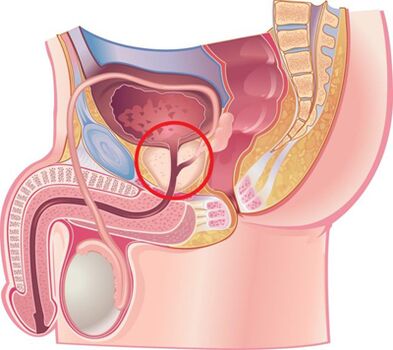
Causes of the disease
Chronic prostatitis is currently considered a polyethiological disease. There is an opinion that the disease occurs as a result of the infection penetrating the prostate and then the pathological process progresses without its involvement. A number of non-communicable factors contribute to this.
Infectious factors in the development of chronic prostatitis
In 90% of cases, the pathogens enter the gland from the urethra, resulting in acute or chronic prostatitis. Asymptomatic delivery has taken place. The course of the disease is influenced by the state of the human body's defenses and the biological properties of the pathogen. It is hypothesized that the transition from acute prostatitis to chronic prostatitis is due to a loss of tissue elasticity due to overproduction of fibrous tissues.
The pathogens of chronic prostatitis include the following:
- In 90% of cases, the disease reveals Gram-negative bacteria such as Escherichia coli (E. coli), Enterococcus faecalis (faecal enterococcus), and, less commonly, Pseudomonas aeruginosa, Klebsiella spp. , Proteus spp. , Pseudomonas aeruginogenes and Enterobacter. Gram-positive enterococci, streptococci, and staphylococci are rare.
- The role of coagulase-negative staphylococci, ureaplasma, chlamydia, Trichomonas, gardnerella, anaerobic bacteria, and fungi of the genus Candida has not been fully elucidated.
The infection enters the prostate in several ways:
- The most likely upward path is evidenced by the frequent combination of prostatitis and urethritis.
- Hematogenous prostatitis develops when the infection enters the gland through the bloodstream, which is caused by chronic tonsillitis, sinusitis, periodontitis, pneumonia, cholecystitis and cholangitis, purulent skin diseases, and so on.
- Upon contact, chronic prostatitis develops with urethritis and urethral stricture, when the infection enters a growing gland through the flow of urine, purulent kidney infections, epipidymitis, deferentitis and funiculitis through the canal, diagnostic and therapeutic catheterization, diagnostic and therapeutic urological manipulations.
- Lymphogenous infection penetrates the prostate, proctitis, hemorrhoidal veins thrombophlebitis, etc.

Non-infectious factors in the development of chronic prostatitis
Chemical factors
Experts say the leading role in the development of chronic prostatitis is due to the intraprostatic reflux of urine, when urine is thrown from the urethra into the gland, leading to damaged emptying of the prostate and bladders.
The disease develops vascular reactions leading to organ edema, impaired neural and humoral regulation of the tone of urethral smooth muscle tissues, and activation of alpha.one–Adrenergic receptors induce dynamic obstruction and contribute to the development of new intraprostatic refluxes.
Urates in the urine lead to a "chemical inflammatory reaction" in addition to reflux.
Hemodynamic disorders
They support chronic inflammation and circulatory disorders of the pelvic organs and scrotum. Congestion develops in sedentary people such as drivers, office workers, etc. , Obesity, sexual abstinence, sexual dysmetry, frequent hypothermia, mental and physical overload. Spicy and spicy food, alcohol and smoking, etc. Its intake contributes to the maintenance of the inflammatory process.
Other factors
Many other factors support chronic prostatitis. These include:
- Hormonal.
- Biochemical.
- Impaired immune response.
- Autoimmune mechanisms.
- Infectious and allergic processes.
- Characteristics of the structure of the prostate glands leading to complete drainage.
The causes of chronic prostatitis often cannot be determined.
Classification of prostatitis
According to the classification proposed by the National Institute of the United States in 1995, prostatitis is divided into:
- Acute (Category I). 5-10%.
- Chronic bacteria (Category II). 6-10%.
- Chronic, non - bacterial inflammation (category IIIA). 80-90%.
- Chronic, non-bacterial, non-inflammatory (category IIIB) or chronic pelvic pain syndrome.
- Chronic prostatitis, accidentally diagnosed (Category IV).
Signs and symptoms of chronic prostatitis
The course of chronic prostatitis is long but not monotonic. Periods of exacerbation are replaced by relative calm, which occurs after complex anti-inflammatory and antibacterial therapy.
The development of chronic bacterial prostatitis is often preceded by bacterial or gonorrheal urethritis, non-bacterial circulatory disorders in the pelvic organs and scrotum (hemorrhoids, varicocella, etc. ), sexual exaggeration.
Patients with chronic prostatitis have many complaints. They visit doctors for years, but are very rarely examined for prostate disease. About a quarter of patients do not complain or the disease has few clinical symptoms.
Complaints from patients with chronic prostatitis can be conditionally divided into several groups.
Urinary incontinence with urethral stricture:
- Difficulty at the beginning of urination.
- Poor urine flow.
- Periodic or drip urination.
- Feeling of incomplete emptying of the bladder.
Symptoms due to irritation of nerve endings:
- Frequent urination.
- The urge to urinate is sharp and violent.
- Urine in small portions.
- Urinary incontinence during urination.
Pain syndrome:
- The intensity and nature of the pain varies.
- Localization of pain: lower abdomen, perineum, rectum, lumbar and lower back, inner thigh.
Sexual dysfunction:
- Pain in the rectum and urethra during ejaculation.
- Slow erection.
- Loss of orgasm.
- Premature ejaculation, etc.
On the nervous system: neurotic disorders in the form of raising awareness of patients ’health.
Signs and symptoms of chronic, non-bacterial prostatitis
Chronic pelvic pain syndrome in men (CPPS) occurs with the usual symptoms of chronic prostatitis, but bacteria are absent in urine part 3 and prostate secretions. CPPS can be simulated by chronic, non-bacterial interstitial cystitis, rectal diseases, spastic pelvic floor myalgia syndrome, and functional prostate lesions caused by disorders of organ innervation and hemodynamics.
When neurovegetative function is impaired, atony and violation of glandular innervation are detected, which is manifested in the difficulty in closing the urethral lumen quickly and completely. However, urine after urination decreases dropwise for a long time. In such patients, the study reveals instability and increased irritability, manifested by increased sweating and irritability of cardiac activity, changes in dermography.
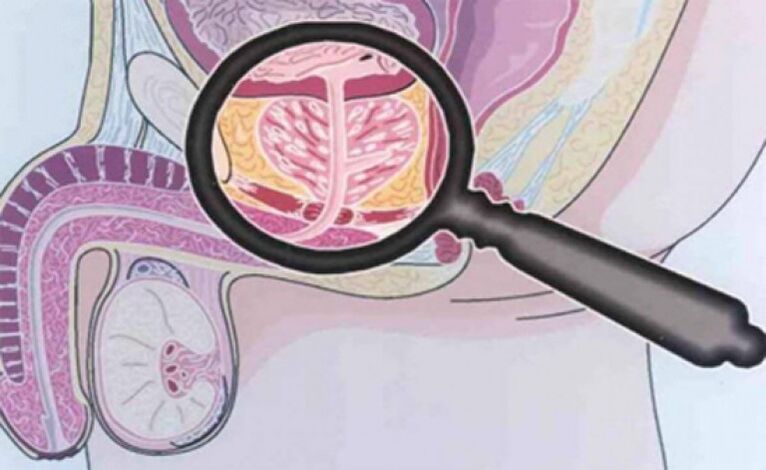
Complications of the disease
The long course of chronic prostatitis is complicated by impaired sexual and reproductive functions, the development of diseases such as vesiculitis and epipidymitis, and hardening of the organ. Organ sclerosis impairs local microcirculation and urodynamics as well as the results of surgical interventions. Fibrosis of periurethral tissues leads to the development of urinary disorders.
Diagnostics
Due to the fact that there are many causes of chronic prostatitis, a whole range of diagnostic tests are used to diagnose it. The success of treatment depends on the correct definition of the causes of the disease. The diagnosis of chronic prostatitis is based on the following data:
- A classic triad of symptoms.
- A set of physical methods (digital rectal examination of the prostate).
- A set of laboratory methods (urinalysis and microscopic examination of prostate secretion, culture and determination of susceptibility of microflora to antibacterial drugs, general analysis of urine and blood).
- For the detection of gonococci, bacterioscopy of urethral smear, PCR and serological methods (for the detection of ureaplasmas and chlamydia).
- Urofluometry.
- Prostate biopsy.
- Complex of instrumental methods (ultrasound).
- Determining the patient's immune status.
- Determination of neurological status.
- If treatment is ineffective and complications are suspected, computer and magnetic resonance imaging, blood culture, etc. should be used.
Feeling the prostate
Of paramount importance in the diagnosis of the disease is the palpation of the prostate, which increases during the period of exacerbation and decreases during the alleviation of the inflammatory process. In chronic prostatitis, iron exacerbation is edematous and painful.
The density of the consistency of the organ can be different: they feel the area of softening and compaction, they define the zones of depressions. The shape of the gland, the condition of seminal tuberculosis and the surrounding tissues can be assessed by touch.
The process of transrectal digital examination is linked to the collection of glandular secretions. Sometimes it becomes necessary to obtain the secret from each stock separately.
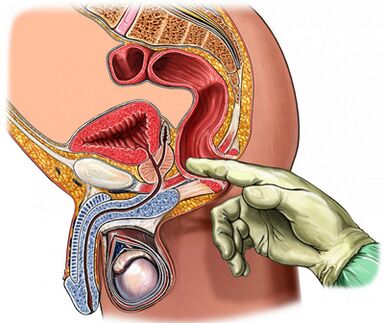
Analysis of 3 vials of urine sample and prostate secretion
The "gold standard" in the diagnosis of chronic prostatitis:
- Collection of the first part of the urine.
- Collection of the second part of the urine.
- Obtaining glandular secretions with massage.
- Collection of the third part of the urine.
The material is then examined microscopically and bacteriologically.
With inflammation of the prostate:
- The number of microbes (CFU) exceeds 103/ ml (10four/ ml for epidermal staphylococci), but do not ignore the small number of microbes in the tens and hundreds.
- The presence of 10-15 leukocytes detected by microscopy in the field of view is a generally accepted criterion for the presence of the inflammatory process.
The secretion of the prostate and part 3 of the urine are subjected to microscopic and bacteriological examinations:
- In the case of chronic bacterial prostatitis, the number of leukocytes increases in the secretion of the gland and in the part of the urine after the third massage, and bacteria (mainly belonging to the intestinal group) are released.
- In non-bacterial prostatitis, the number of leukocytes in the secretion of the gland increases, but the microflora is not detected.
- There is no increased leukocyte and microflora count using CPPS.
Normal rate of prostate secretion:
- Leukocytes are less than 10 in the field of view.
- There are a lot of lecithin in the eyes.
- The microflora is missing.
In chronic prostatitis, prostate secretion reveals:
- The number of leukocytes is large - more than 10-15 in the field of view.
- The amount of lecithin particles decreases.
- The pH of the secretion shifts to the alkaline side.
- The content of acid phosphatase decreases.
- Lysozyme activity increases.
Obtaining negative results for prostate secretion never proves the absence of an inflammatory process.
The value of the prostate secretion crystallization test is retained. Normally, during crystallization, a characteristic pattern is formed in the form of a fern leaf. Violation of the aggregation properties of prostate secretion does not result in such a pattern, which occurs when the androgenic hormonal background changes.
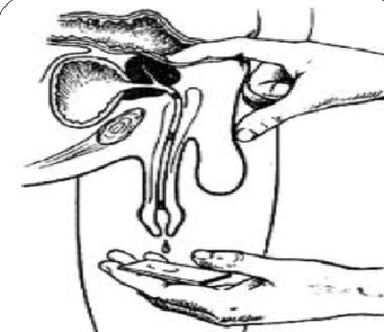
Ultrasound procedure
If prostate disease is suspected, ultrasound of the gland itself is performed (transrectal ultrasound is optimal), kidney and bladder, which allows the determination of:
- Gland volume and size.
- Presence of tartar.
- Size of seminal vesicles.
- Condition of bladder walls.
- The amount of urine remaining.
- Testicular structures.
- Another type of pathology.
Other methods of examining the prostate
- The state of urodynamics (study of urine flow rate) can be easily and simply determined using a study such as uroflowmetry. With the help of this study, signs of bladder outlet occlusion can be recognized in time and dynamic observation can be performed.
- A pricked biopsy is performed if abscess formation, benign hyperplasia, and prostate cancer are suspected.
- X-rays and endoscopic examinations are performed to clarify the causes of infravesicular obstruction.
- Urethrocystoscopy is recommended for long-term inflammatory processes.
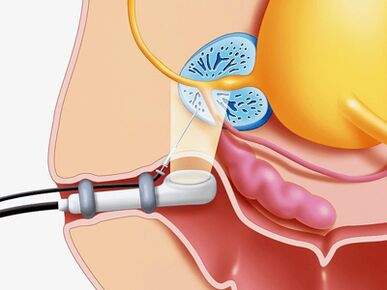
Differential diagnosis
The chronic prostate inflammation must be distinguished from the vesiculoprostatostasistól, autonomous prosztatopátiától, congestive prosztatagyulladástól, the pelvic floor myalgiájától, neuropsychiatric disorders, the pszeudodysszinergiától, reflex sympathetic disztrófiától other organs inflammatory diseases of: interstitial cystitis, hooded articulation osteitis, cervical hyperthyroidism prostate, urolithiasis, chronic epipidymitis, inguinal hernia.
Treatment of chronic prostatitis
Treatment of chronic prostatitis should begin with a change in the patient's lifestyle and diet.
Drugs that affect different pathogenesis relationships are used simultaneously in the treatment of the disease.
The main directions of therapy:
- Elimination of causal microorganisms.
- Anti-inflammatory therapy.
- Normalization of blood circulation in the prostate and pelvic organs.
- Normalization of proper prostatic drainage.
- Normalization of the hormonal profile.
- Prevention of hardening of the organ.
The following groups of drugs are used to treat chronic prostatitis:
- Antibacterial.
- Anticholinergic.
- Vasodilators.
- Alphaone–Adrenergic blockers.
- 5 alpha-reductase inhibitor.
- Cytokine inhibitors.
- Non-steroidal anti-inflammatory drug.
- Angioprotectors.
- Immunomodulators.
- Drugs that affect urate metabolism.
Antibiotics in the treatment of chronic bacterial prostatitis
Antibiotic therapy should be performed taking into account the susceptibility of the identified microorganisms to antibiotics. If the pathogen is not identified, empirical antimicrobial therapy is used.
The drugs of choice are fluoroquinolones of generation II-IV. They penetrate rapidly into glandular tissues by standard methods of application and are active against gram-negative microorganisms and a large group of ureaplasma and chlamydia. In case of failure of antimicrobial treatment, the following should be assumed:
- multidrug resistance of the microflora,
- short courses (less than 4 weeks),
- incorrect choice and administration of the antibiotic,
- changes in the type of pathogen,
- the presence of bacteria living in the channels of the prostate, covered with a protective extracellular membrane.
The duration of treatment should be at least 4 weeks with mandatory mandatory bacteriological control. If there are more than 10 bacteriuria in Part 3 of urine and prostate secretion3CFU / ml, repeated antibiotic therapy is prescribed for 2-4 weeks.
Cytokine inhibitors in the treatment of chronic prostatitis
Cytokines are glycoproteins that are secreted by immune and other cells in response to inflammatory and immune responses. They are actively involved in the development of the chronic inflammatory process.
Non-steroidal anti-inflammatory drugs
Non-steroidal anti-inflammatory drugs have anti-inflammatory effects, relieving pain and fever. It is widely used to treat chronic prostatitis in the form of tablets and suppositories. The most effective route is rectal administration.
Immune therapy
In addition to antibiotics and anti-inflammatory drugs, immunomodulatory agents are used in the treatment of bacterial chronic prostatitis. The most effective route is rectal administration. An immunomodulator is widely used, which increases the functional activity of phagocytes, which contributes to a more efficient elimination of pathogens.
Alpha-blockers in the treatment of chronic prostatitis
Alpha-1 adrenergic blockers have been found to normalize the tone of smooth muscle in the prostate urethra, bladder, and prostate capsule, making drugs in this group very effective in treating the disease. Alpha-1 adrenergic blockers are used in patients with severe urinary disorders in the absence of an active inflammatory process.
For CPPS, the duration of treatment is 1-6 months.
5α-reductase inhibitor in the treatment of bacterial prostatitis and CPPS
It has been found that the enzyme 5α-reductase converts testosterone to the prostate form of 5α-dihydrotestosterone, which has an activity in prostate cells more than five times that of testosterone itself, leading to an increase in the organ caused by epithelial and stromal components in the elderly.
When the 5α-reductase inhibitor is taken for 3 months, atrophy of the stromal tissue is observed, within 6 months - gland, inhibition of secretory function, severity of pain syndrome and gland volume, organ tension and edema are reduced.
The role of antisclerotic drugs in the treatment of chronic prostatitis
Prolonged inflammation of the prostate gland develops fibrosis, which manifests itself in impaired microcirculation and urodynamics. Anti-sclerotic drugs are used to prevent the process of fibrosis.
Other medicines used to treat chronic prostatitis
In addition to the medicines described above, the following are used to treat the disease:
- Antihistamines.
- Vasodilators and angioprotectors.
- Immunosuppressants.
- Drugs that affect the metabolism of urate and the trisodium salt of citric acid.
Vegetable products
In the treatment of prostatitis, it is effective to use a composition containing a complex of biologically active peptides isolated from the bovine prostate gland in the form of suppositories.
Under the influence of the drug:
- Stimulation of metabolic processes in glandular tissues.
- Improving microcirculation.
- Edema, leukocyte infiltration, stagnation of secretions and reduction of pain.
- Prevention of thrombosis in the venous gland of the prostate gland.
- Increased activity of the secretory epithelium of the acini.
- Improving sexual function (increasing libido, restoring erectile function, and normalizing spermatogenesis).
Massage of the prostate gland
Many researchers argue that finger massage should be used in chronic prostatitis, taking into account known contraindications.
Physiotherapy
The efficacy of physiotherapy procedures in the treatment of prostatitis has not been proven today, the mechanism of action has not been scientifically established, and side effects have not been studied.
Prevention of chronic prostatitis
To prevent the development of chronic prostatitis, you need to know:
- The risk of developing the disease increases over the years.
- Representatives of the Negroid race are more prone to the disease.
- It is possible that the family is prone to the disease.
People who are prone to developing chronic prostatitis need to pay more attention to their health.
Disease prevention tips:
- Drink plenty of fluids. Frequent urination helps to wash out the microflora from the urethra.
- Prevention of diarrhea and constipation.
- Eat a balanced diet. Avoid eating foods high in carbohydrates and saturated fats, which leads to weight gain.
- You should limit the use of urinary tract irritants: spicy and spicy foods, smoked meats, sauces and condiments, coffee and alcohol.
- Don't smoke. Nicotine adversely affects the condition of blood vessel walls.
- Do not overcool.
- Do not keep the bladder emptying.
- Lead an active lifestyle, exercise. It exercises to strengthen the muscles in the pelvic floor, which eliminates venous congestion, which in turn supports the normal functioning of the prostate.
- Live a regular sex life. Avoid prolonged abstinence. The gland must be immediately freed from secrecy.
- Stay in a monogamous relationship. Unsorted sex increases the likelihood of acquiring sexually transmitted diseases.
- If you have any complaints from the urogenital organs, contact your urologist immediately.

























